
Silicon chips have been the foundation of power electronics over the years. However, as more applications are using increasingly higher amounts of electrical power, silicon has begun to reach its limits. Wide band gap semiconductors offer an opportunity to surpass these confines, operating at high frequencies, voltages, and temperatures. Looking to optimize their development of wide band gap solutions, engineers at Wolfspeed utilized the power of the Application Builder within COMSOL Multiphysics.
Wide Band Gap Semiconductors: A New Generation of Power Electronics
Look at any device that uses electricity and you will likely find a power electronic system at the heart of its operation.Power electronicsrefers to the technology that is used to control and convert power from one form to another. While the conversion process may vary depending on the application, the goal remains the same — process power efficiently, safely, and at a low cost.
Silicon devices, namely insulated-gate bipolar transistors (IGBTs), currently dominate the power electronics industry. These power electronic converters are used to process most sources of electricity at least once or, more often, multiple times. The efficiency of these converters typically ranges from 70% to 90%, which translates into large amounts of money being wasted.
In recent years, wide band gap semiconductors such as silicon carbide (SiC) have given new hope in advancing power electronics systems. These materials feature band gaps that are significantly higher than their silicon counterparts, improving the power quality of the electronic devices that rely on them while reducing their size and energy losses. As theU.S. Department of Energy noted in a 2014 article, wide band gap semiconductors are essential to developing the next generation of high-performance power electronics and will lead to more affordable products and large energy savings.


Cell phones and electric vehicles are just two examples of technologies that rely on power electronics. The use of wide band gap semiconductors within these systems could help them become more reliable and efficient. Image on left by Reinraum — Own work, viaWikimedia Commons. Image on right by NJo — Own work, viaWikimedia Commons.
COMSOL Multiphysics, an Essential Analysis Tool
When studying wide band gap semiconductors and their relationship to the electronic system as a whole, it’s important to consider the effects and interaction of a variety of physical phenomena, including thermal, electrical, and mechanical behavior. At Wolfspeed, this has prompted a simulation-based approach to such analyses using COMSOL Multiphysics, a platform that is utilized across many projects throughout the company.
“COMSOL Multiphysics simulations have been essential tools for our engineers to extract a more detailed understanding of our products, virtually assess real-world performance, and reduce the amount of prototyping needed,” Brice McPherson, a development engineer at Wolfspeed, stated in aMultiphysics Simulation2015 article.
With simulation as a key element in their design workflow, engineers at Wolfspeed embraced the concept of creating apps to further extend the reach and benefits of simulation power. This journey began with the development of applications to analyze the wide band gap technology discussed above.
The First Wolfspeed App: A Semiconductor Packaging Design Tool
The first simulation app that Wolfspeed created was based on a simple geometry. The purpose of the app was to evaluate the fusing current and impedance of the wires designed to interconnect semiconductor devices. The results from the simulation tests helped determine how many of the tiny bond wires were necessary within a particular application.
The app was built around a complex, parameterized model, ensuring accuracy in the simulation results while presenting the necessary information in a user-friendly format. A drag-and-drop user interface (UI) and intuitive control and entry fields helped narrow the learning curve behind building the app, simplifying the overall design process.
Tailoring the Simulation Experience to User Needs with Apps
This app was just the start. Next, the team developed an app to help configure and analyze arrangements of SiC MOSFETs and diodes in their high-performance power modules. The app, shown below, automatically arranges devices in the available area, applies relevant thermal conditions, and provides users with a realistic approximation of how hot the devices will become at their specific operating point. All of the relevant performance metrics, including thermal resistance, loop inductance, package resistance, and parasitic capacitance, are included in the app’s results.

The Wolfspeed app’s UI.
Since then, engineers at Wolfspeed have continued to develop more apps, ranging from simple design tools to more complex analyzers. Newer apps have been distributed to people throughout the company’s engineering team, helping to optimize the design workflow and provide a better prediction of how products will perform. For supervisors and those on the marketing team, simulation apps have also proven to be a powerful tool, enabling them to address customer requests more promptly and effectively.
“The Application Builder tailors the simulation experience to your needs and makes simulation more accessible to a wider audience,” McPherson stated. “It is an enormous way for engineers to save time.”
The Future of Simulation Apps at Wolfspeed
As we just saw, Wolfspeed is already experiencing many of the benefits of building and distributing simulation apps. As they look ahead to the future, some points of focus include adding complexity to the underlying models of the apps as well as increasing the accuracy of their simulation tools. Once a greater number of apps have been developed, there are plans to eventually create a suite of apps and host them onCOMSOL Server™.
Managers Can Use Apps to Train New Employees
The team at Wolfspeed is also hoping to use apps as a way to train new employees during the onboarding process. The Application Builder is designed to hide the complexity of an actual model, instead showing only those parameters that are relevant to a specific analysis. Trying out apps thus provides a simple introduction to the COMSOL Multiphysics software platform, helping employees become familiar with the feel of the software while encouraging them to dig deeper into the full extent of how it works. And, as McPherson mentions, using apps to demonstrate the effects of changing the variables and conditions on structures specific to the company’s industry serves as a great way to introduce employees to their new line of work.
Testing New Product Designs
Designing apps for products is another point of interest at the company. These simulation tools could be useful to companies or people across a wide range of industries. Once deployed, the apps could serve as foundations for different groups to run their own simulation tests based on design needs for their specific product.
Further Reading
- Read a related article on page 32 ofMultiphysics Simulation2015, anIEEE Spectruminsert: “Simulation Apps Streamline the Design of Power Electronics”.
- Check out these blog posts to learn how others are utilizing the Application Builder:



Comments (0)